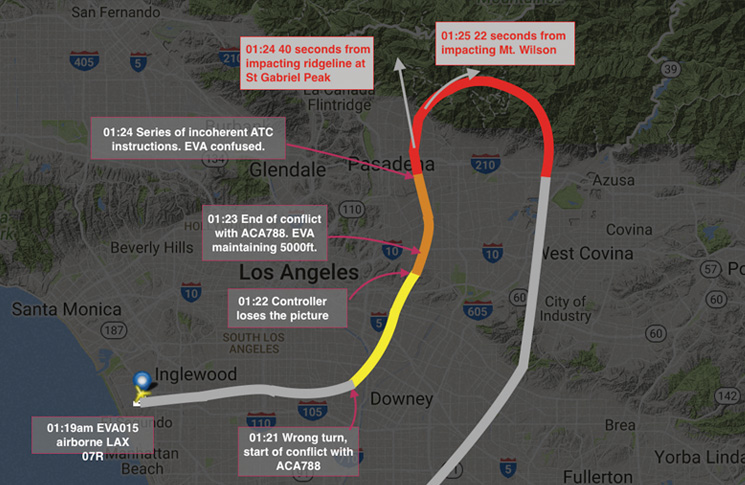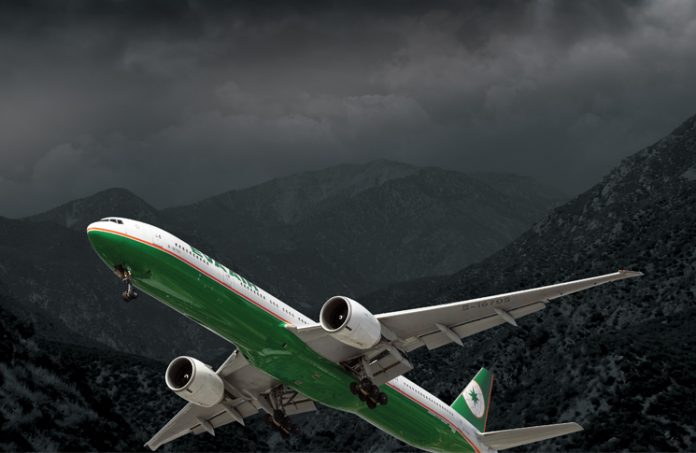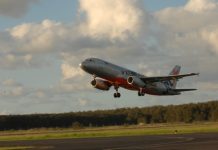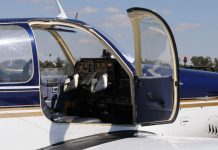In this incident, ATC miscommunication and broader organisational factors almost led to the loss of 353 lives.
By Margo Marchbank
On 16 December 2016, EVA Air flight 015 was only 40 seconds—0.5 nautical miles laterally and zero feet vertically—from crashing into a mountain.
The Boeing 777-35EER with 353 people on board had departed Los Angeles International Airport (LAX) at 01:19 local time, bound for Taipei-Taiwan Taoyuan International Airport.
With diversions due to storms, the airport’s normal departure operations to the west and over the sea, used for more than 90 per cent of departures, were changed. Instead, departures were via the less familiar easterly operations, using runway 07R/25L. North-east of Los Angeles are the San Gabriel Mountains, a range of substantial peaks which includes Mount St Antonio, the highest at 10,064 feet and Mount Wilson, 5710 feet. Mount Wilson is about 30–40 miles (40–50 km) from LAX and is home to an observatory and a towering array of TV and radio antennae, the tallest of which is more than 970 feet.
EVA Air received take-off clearance from runway 07R at 01:17:49. The LAX air traffic controller transferred communications to Southern Californian Terminal Radar Approach Control—SCT or SoCal TRACON, one of the busiest ATC facilities in the world—at 01:19:54. The communication failure that followed in the next five minutes—with the aircraft being told to turn left instead of right—almost led to the disaster of EVA Air’s controlled flight into Mount Wilson. It was sheer happenstance that this didn’t occur.

What went wrong?
The truth about most aviation accidents and incidents is rarely pure—and never simple. The EVA015 incident is no different. Aviation bloggers, armchair pilots and social media trolls were quick to adopt the simple answer—blame the controller. One wrote, ‘100 per cent controller error … 37 years ATC experience, and I can’t recall a performance this bad’.
Michael Kay is president of the International Civil Aviation English Association and an aviation English team leader with AeroThai, the Thai state air navigation service provider.
He says there are obvious non-standard phraseology issues at play in this near miss, but there are broader and more nuanced cultural and organisational factors to consider.
When EVA 015 reads back the original, and incorrect, ‘left heading 180’, the controller ignores it. Kay guesses the Taiwanese pilots then fixated on that instruction, leading them to continue north in a long wide turn, and into potential conflict not only with the peaks of the San Gabriel Mountains but, more urgently, Air Canada flight 788.
Maintaining separation is the controller’s raison d’être, as the Federal Aviation Administration’s (FAA) ATC orders 7110.65 says: ‘The primary purpose of (ATC) is to prevent a collision between aircraft operating in the system’. For the controller, losing separation has immediate physiological effects (an adrenaline rush, increased heart and breathing rates) as well as psychological effects.
At this point, with these powerful stressors affecting her performance, the SoCal controller seems to lose her situational awareness and becomes increasingly impatient. She ignores EVA’s request for a heading confirmation and, instead of using standard phraseology, ‘Turn right, heading xxx’, asks patronisingly, ‘EVA 015 heavy, what are you doing?’ In a short-tempered tone, the controller instructs them to, ‘Turn southbound now! Southbound now!’.
‘Southbound’ implies you are already travelling in that direction and is ambiguous to a non-native speaker. ‘She does not attempt to modify her instruction,’ Kay says, ‘and keeps repeating the same non-standard phraseology’, oblivious to EVA 015’s incomprehension. Their readback ‘Roger, turn southbound now, EVA 015 heavy’, is parrotlike, to the extent of ‘echoing her emphatic “now”, which shows they do not understand’, he says. Losing confidence, concerned about losing face, and confused because of a barrage of contradictory instructions, the pilots do not question any further, and ‘relinquish authority to the native speaker’, he says.
At 01:24:25 there is a different voice on EVA 015’s radio—presumably the captain has taken control, rather than having the pilot not-flying relay transmissions. Data from the aircraft shows the enhanced ground proximity warning system (EGPWS) generated four ‘Caution, terrain’ alerts at 01:24:30, followed 11 seconds after by a further four. Eight seconds later, the EGPWS ‘pull up!’ alert activated, lasting seven seconds. The captain takes control, and with the insistent EGWPS warnings still ringing in their ears, the aircraft finally turns south, climbing away from danger.
‘The controller talks very quickly and her transmissions are too long for the situation, the work culture exacerbates the whole situation,’ Kay says.
The NTSB report determined the probable cause as:
- The incident was caused by the air traffic controller assigning the pilots a left turn instead of the required right turn after departure which placed the aircraft in an unsafe proximity with terrain and obstructions. Contributing to the incident was the air traffic controller’s inadequate recovery technique during the development of the incident.
LAX is a very busy and complex airport. At the time of the incident, according to the Los Angeles Times, air traffic control for LAX handled 1700–1800 departures and arrivals daily. To cope with this traffic, controllers feel compelled to speak rapidly, often making comprehension difficult for non-native English speakers.
Researchers based in Japan (Nitta, Okazaki and Klinger, 2011) measured the speed of American ATC speech at three major US airports, including LAX. They found high speech rates: a median of 6.1 syllables per second for ATC compared to 5.1 syllables for US movies and 4.7 for news broadcasts. The faster the speech rate, the more non-native speakers missed or misheard words—about 21 per cent of words in sentences spoken at
six syllables per second, which rose to 41 per cent at eight syllables per second.
There are also other organisational and cultural factors which should be considered, such as fatigue. In its investigation of the incident, the US National Transportation Safety Board (NTSB) interviewed 14 ATC/FAA personnel, including the controller, her colleagues, quality assurance and control staff and ATC supervisors/managers.
A common theme which emerged was the frequency of overtime worked by operational personnel. One manager said he had worked 15 six-day weeks in the 17 leading to the incident, while the incident controller said she regularly worked a six-day week due to staff shortages. On the day of the incident, she had worked a 0545 to 1345 shift, followed by a 2200 to 0600 shift, with about three hours sleep between these shifts. According to figures quoted in the LA Times, an ageing controller workforce and a complex, demanding ATC environment at LAX meant ATC overtime grew from 5866 hours in 2008 to 13,396 in 2015, the year before the incident.
Likely fatigue, and the additional workload created by the infrequent east operation—which one NTSB interviewee said led to ‘the incident controller working double the number of aircraft that the sector normally worked at that time of the morning’—together with the cultural acceptance of informal, non-standard phraseology combined to create a perfect storm. Miraculously, this time, the storm abated without damage.
Radio communication EVA Air and Southern California Control (SoCal)
16 December 2016
|
0120:07 |
SoCal Departure: Hello Eva 015 heavy, SoCal Departure, radar contact, climb and maintain 7000 (feet). Fly heading 090. |
|
EVA 15: Climb and maintain 7000 (feet) upon what heading? |
|
|
SoCal Departure: Heading 090, to 7000, EVA 015 heavy. |
|
|
EVA 15: Heading 090, 7000 EVA 015 heavy. |
|
|
0121:16 |
… SoCal Departure: (unreadable) … 180, climb and maintain 7000. |
|
EVA 15: Left heading 180 (south), climb and maintain 7000 EVA 15 heavy. |
|
|
EVA 15: EVA 15 heavy, request high speed climb. |
|
|
SoCal Departure: EVA 15 heavy, affirmative, approved as requested. |
|
|
EVA 15: Approved, EVA 015 heavy. |
|
|
0121:57 |
SoCal Departure: … turn right, turn heading 180. (Approx 41 secs later) |
|
EVA 15: Copied, right heading 180, EVA 15 heavy. |
|
|
0122:10 |
SoCal Departure: … please expedite your right turn. |
|
EVA 15: EVA 15 heavy, roger … passing heading 010, continue right turn heading. |
|
|
0122:30 |
SoCal Departure: (instructing Air Canada flight 788, 5.45 nm west of EVA015 to increase its rate of climb to avoid conflict) SoCal Departure: EVA 15 heavy, stop your climb! |
|
EVA 15: Stop climb, EVA 015 heavy. |
|
|
SoCal Departure: (giving further instructions to Air Canada 788) |
|
|
SoCal Departure: EVA 15 heavy, turn left, left turn to a heading of ah … 29 … ah, 270 (direction west) |
|
|
EVA 15: Left heading 270, EVA 015 heavy. |
|
|
0123:04 |
SoCal Departure: EVA 015 heavy, what are you doing? Turn southbound now! Southbound now! Stop your climb. |
|
0123:30 |
EVA 15: Confirm, EVA 015 heavy, maintain 5000 (feet), left … right, right heading (unintelligible). EVA 15 (different voice): EVA 015 heavy, confirm the heading. |
|
SoCal Departure: Captain EVA 015 heavy, turn southbound, southbound now. |
|
|
EVA 15: Roger turn southbound now, EVA 015 heavy. |
|
|
0124:03 |
… SoCal Departure: EVA 015 heavy, climb and maintain 5000, and are you southbound now? I see you’re going northbound, climb and maintain 6000. |
|
EVA 15: … (unreadable) … south, maintain 5000, EVA 015 heavy. |
|
|
SoCal Departure: EVA 015 heavy, climb and maintain 7000. |
|
|
EVA 15: Climb and maintain 7000, EVA 015 heavy. |
|
|
0124:25 |
SoCal Departure: 15 heavy, I see you’re going southbound, turn south … cause I see you’re going northbound, turn south now, climb and maintain 7000. … SoCal Departure: EVA 015 heavy, climb and maintain 7000 and turn south NOW! |
|
EVA 15 (different voice): … (blocked transmission) … right turn to southbound, continue climb 7000. |
|
|
SoCal Departure: EVA 015 heavy, affirmative. |
|
|
0126:25 |
EVA 15: … continue right turn, climb to 7000 to heading 1-8-0. … EVA 15: SoCal, EVA 015 heavy, 180, 7000. |
|
SoCal Departure: EVA 015 heavy, affirmative, climb and maintain, maintain 7000. |






Jesus even a native local driver would be under the pump getting pushed about like a billiard ball on a pool table with that R/T terrorist! She was damned lucky she didn’t bury hundreds of people!
Tough situation. LAX is busy and complicated, and works many foreign carriers. I always tried to reduce my speech rate with non-native English speakers, but some days you get busy. I wonder why EVA didn’t commence an emergency climb with the low altitude alert?
old to stop his climb in no uncertain terms, and it looks like in the end the Captain took over and got it together